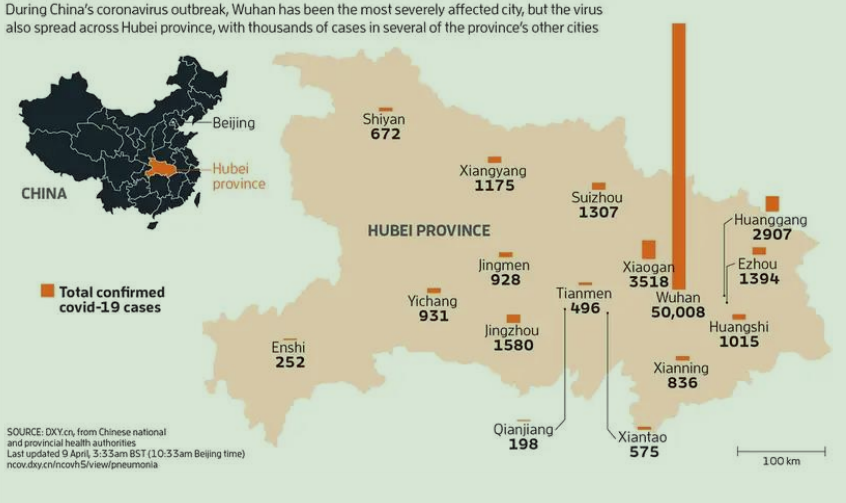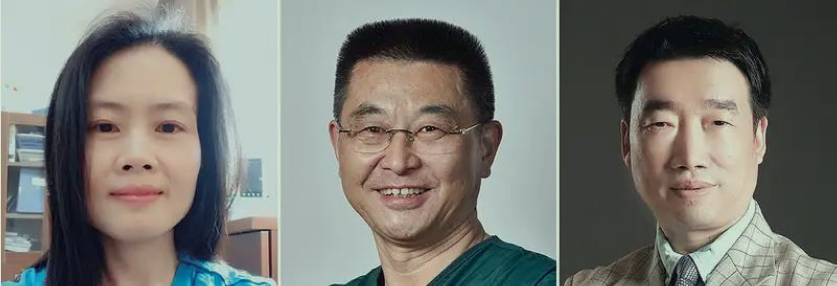Three doctors reveal what it was like at the heart of Hubei province’s coronavirus crisis, as the epidemic peaked in Wuhan and spread elsewhere
HEALTH 15 April 2020
By Donna Lu

An intensive care unit at Zhongnan Hospital in Wuhan, China (Xinhua/Xiong Qi/PaImages)
WUHAN – the city where the coronavirus pandemic began – has partially lifted its lockdown, with the epidemic that spread through the city and out across the surrounding province of Hubei under control for the time being. In early April, New Scientist spoke to three doctors about life at the peak of the province’s crisis.
What were your roles in the coronavirus outbreak?
Xiang Lu: I led a medical aid team of more than 300 people from Jiangsu province to Huangshi [a city in Hubei province]. Our doctors were assigned to eight designated hospitals with coronavirus patients.
Zhiyong Peng: I manage the intensive care unit (ICU) at Zhongnan Hospital in Wuhan, with 30 doctors.
Yi Han: I first worked in the ICU at Wuhan First Hospital, and now I’m in Jinyintan Hospital. I’m currently looking after 13 critically ill patients, including four who are intubated, and one patient who is on extracorporeal membrane oxygenation (ECMO) .
When did you first arrive in Hubei province?
XL: Our team arrived in Huangshi on 11 February. The timeline in Huangshi was slightly behind that of Wuhan. The first patient admitted to the hospital [in Huangshi] was on 20 January. By the time we arrived, cases had spiked to around 700 patients in hospital and there were dozens of new patients being admitted every day. In total across Huangshi we had 100 critically ill patients.
YH: I arrived in Wuhan on 13 February. When we first came here, there were quite a lot of patients. At that time, we took over a ward with about 70 to 80 patients.
What was it like at the peak of the outbreak?
XL: At the peak, [Hubei province] had about 20,000 medical personnel from across China who came to help, working in more than 50 hospitals.
ZP: At the busiest, [the Zhongnan Hospital] had three ICU units looking after 44 critically ill covid-19 patients. Our ICU is one of the biggest in Wuhan. From our experience, the average [ICU] mortality rate was around 25 to 30 per cent.
YH: At the busiest time, I was in the Wuhan First Hospital, working in the ECMO machine group. We worked for 6-hour shifts. The protective suit you wear is completely airtight, and the goggles and protective mask make your whole body tired. After 6 hours, you feel like collapsing. Every time you come out, the overwhelming feeling is: “I have to drink a mouthful of water, otherwise I might die of dehydration.” I had no concept of time at all, just working and trying to rest as much as possible during the short downtime.
Were there any shortages?
YH: At the busiest time, there weren’t enough supplies. There were bed shortages, too. We didn’t have enough equipment until the middle of February. From a national level, we were then supplied with a lot of high-end machines, including ventilators and ECMO machines. Now there’s not really any equipment issues. But even now, we are trying not to be wasteful.
XL: At the most stressful time, we didn’t have enough beds or ventilators. There wasn’t even enough oxygen. The Huangshi infectious diseases hospital used to be for patients with mild disease, but suddenly it was treating so many severe and critically ill cases. We needed to use five to eight ventilators in a ward at once, but the oxygen pressure wasn’t high enough. We then started transferring severely ill patients to the Huangshi Central Hospital, which had a better-equipped ICU.
How are things now?
YH: The overall situation is better. There are still a small number of [covid-19] patients in Jinyintan Hospital receiving treatment. From the perspective of medical staff, even if there’s a rise in cases again, we are now experienced in dealing with this problem.
ZP: We have almost no new cases in our hospital now. All the covid-19 patients will be transferred to a new hospital, Huoshenshan, in about a week’s time. There are about 200 or 300 patients in total still in hospital in Wuhan.
XL: In total, Huangshi had 1015 patients and 39 deaths. About 2800 healthcare workers from Jiangsu province went to Hubei, and now most of them have returned and are quarantining. After our team [of 300] came back to quarantine, our tests have all come back negative and nobody has been infected.
What has working away from home been like?
ZP: We have to [stay] in a hotel and can’t go home, for more than two months already. We work for three weeks and then have one week off. The hospital authorities have invited psychologists to come to our department to talk with our personnel in ICU, and also provide support for living and eating.
XL: Our team lived in three hotels. You had to use the shuttle bus to commute to work. We ate while quarantined too, in our rooms without congregating in a dining hall. Everyone was maintaining social distancing.
YH: Our Jiangsu team is still here in Wuhan. We might be the last to leave. We might go home in mid-April, but we haven’t been given the directive yet. I haven’t seen my child for a long time.

What measures worked well while treating patients?
ZP: All medical staff received regular testing, every three to four weeks. There was additional testing if you had symptoms or if one of your colleagues was infected. It was very important to protect all our medical staff.
XL: In terms of managing patients with covid-19, I personally think that preventing mild cases worsening to severe or even critical illness is important, by intervening early.
The approach we take is the same as for other inflammatory responses. If a patient’s level of [the signalling molecule] interleukin-6 is high, we use monoclonal antibodies to suppress the generation of a cytokine storm [a severe and acute inflammatory response]. But this needs to be done early. If the patient’s situation is already very serious, then often it’s too late and nothing you do will work.
YH: I think China’s most effective approach to fighting this epidemic is that it has the space to quarantine these patients. The vast majority of patients with mild cases can effectively recover without transmitting the virus to others, so long as you give them the space to quarantine, with medical support and treatment as needed.
Do you have any advice for other countries?
YH: One point – the most basic and, I think, the most difficult – is that you must provide ample space and facilities for people to quarantine. Having adequate facilities to screen patients is also important, including temperature testing and nucleic acid and antibody testing kits.
“All our medical staff received regular testing. It was very important to protect them” Personal protective equipment is also important. My patients who are being treated are asked to wear masks when they can – even if they are on supplementary oxygen. Worry is warranted but it’s not necessary to panic. We should pay attention to social distancing and self-isolation. Protective materials such as masks should be worn if you are feeling unwell, even if you just have a cold.
The interviews were conducted separately and have been edited for length and clarity.

left to right: Yi Han, Xiang Lu, Zhiyong Peng
Yi Han is a doctor from Jiangsu province who was seconded to Wuhan First Hospital and then Jinyintan Hospital, Wuhan
Xiang Lu is vice-president of Nanjing Medical University, and led a medical aid team from Jiangsu province to Huangshi city
Zhiyong Peng is director of the intensive care unit at Zhongnan Hospital in Wuhan

